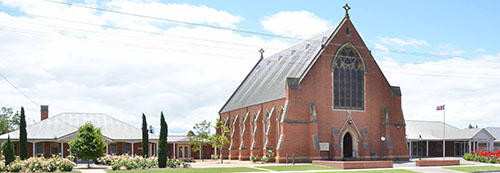THE ANGLICAN CATHEDRAL OF SAINT PAUL, SALE
Brief Review Of Existing Buildings & Elements In The Cathedral Complex
1.1 Cathedral
The Cathedral church was constructed in 1883 to the designs of Nathaniel Billing in the Mainstream Decorated Gothic style. It is constructed in red brick with some rendered and polychrome brick detailing, and is surmounted by a steeply pitched slate gabled roof. There are stained glass windows in the nave and the chancel.
Despite minor alterations, and later additions which are generally attached towards the rear of the Cathedral, the building remains substantially intact. A modern addition towards the rear links the Cathedral to the Chapter House.
The Cathedral is historically significant for its association with the establishment of the Anglican Diocese of Sale, which became a See several years after the construction of the church. The Cathedral is architecturally significant as a notable example of the work of Nathaniel Billing. The Cathedral is an important landmark in a predominantly residential environment and is supported by a number of associated significant buildings in the Cathedral complex, including the Chapter House, Delbridge Hall and Annie Pain Hall, forming a coherent architectural group due to
the consistent use of-red brick construction.
1.2 Chapter House
The Chapter House, located to the west-of the Cathedral, was extensively rebuilt in 1925 by Yuill & Baird of Bairnsdale. It added substantially to the vicarage on this site, which was constructed at he same time as the Cathedral.
The Chapter House is a symmetrical red brick inter War Bungalow, with a low, broad hipped corrugated iron roof, and a returning timber framed verandah, with a half- timber gabled projection over the central entry.
The Chapter House is substantially intact externally, despite modern alterations at the rear.
The Chapter House is historically significant for its association with the establishment of the Anglican Diocese of Sale, and as a residence for local clergy. The Chapter House makes an important architectural contribution to the Cathedral complex, along with the Cathedral itself, Delbridge Hall and Annie Pain Hall, forming a coherent architectural group due to the consistent use of red brick construction.
1.3 Annie Pain Memorial Kindergarten Hall
The Annie Pain Hall was built as a kindergarten and named as a memorial to Mrs Pain, wife of the first Bishop.
The building is constructed in red brick with rendered dressings to window openings and buttress weatherings. There is also some soldier course banding to the main facade, which is otherwise plainly detailed. The hall is surmounted by a steeply pitched gabled colorbond clad roof.
The building is substantially intact externally, though the former RAAF building added to the rear is of little significance.
The Annie Pain Hall is significant for its association with the establishment of the Anglican Diocese of Sale, and as an intact example of a community hall, dating from the Edwardian period. The Hall makes an important architectural contribution to the Cathedral complex, along with the Cathedral itself, Delbridge Hall and the Chapter House, forming a coherent architectural group due to the consistent use of red brick construction.
1.4 Delbridge Hall (now privately owned Delbridge Funeral chapel)
The Delbridge Hall was designed by Clegg, Miller & Morrow, and the foundation stone was laid in 1914. The hall is a simply designed red brick building with rendered dressings to openings, buttresses and parapets. The hall is surmounted by a colorbond clad gabled roof. There is a flat roofed modern brick addition to the
northern side of the hall.
The building retains a high degree of integrity, despite the unsympathetic side addition, both externally and internally. Structural ties have been inserted to stabilize the movement across the width of the proscenium and new hardwood timber floor has recently been introduced to replace the original softwood flooring.
The Delbridge Hall is- significant for its -association with the establishment of the Anglican Diocese of Sale, and as an intact example of a community hall, dating from the Edwardian period. The building has interest for its association with the architectural firm, Clegg, Miller & Morrow, who designed several church buildings in
Sale in the early twentieth century. The .Hall makes an important architectural contribution to the Cathedral complex, along with the Cathedral itself, the Annie Pain Hall and the Chapter House, forming a coherent architectural group due to the consistent use of red brick construction.
1.5 Timber Vestry (now moved and called the ‘Youth Hut’)
The history of the timber vestry is not clear, but it appears to be a building dating from the late 19th century. It is possible this structure was relocated to this site from another parish.
The vestry is a weatherboard clad structure with gothic timber framed windows and a gabled corrugated iron roof. The vestry is distinctive for its internal cladding of stained tongue & groove timber panelling and its heavily architraved timber gothic arched windows.
The vestry is significant for its association with the establishment of the Anglican Diocese of Sale. The vestry makes an important architectural contribution to the Cathedral complex, along with the Cathedral itself, the Delbridge and Annie Pain Halls and the Chapter House.
1.6 Former Dean's Residence
The Dean's Residence is a cream brick veneer probably constructed in the 1960's. The building has limited heritage significance.
FALKINGER ANDRONAS PTY LTD
Architects, Heritage Consultants

